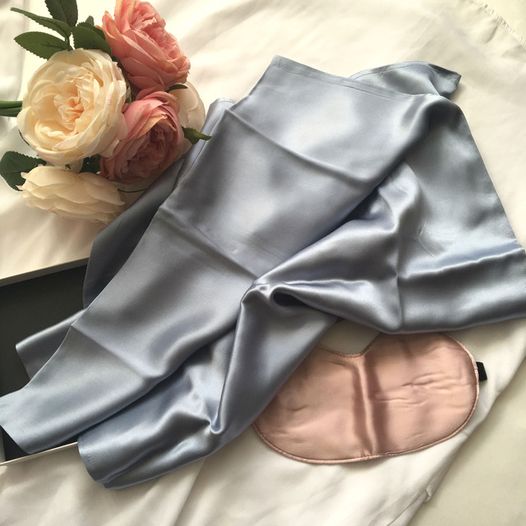TIPS FOR DISTINGUISHING SILK
About Silk Fabrics
The real silk fabric is pure white woven mulberry silk fabric, which is woven with twill weave. According to the weight of the fabric in square meters, it is divided into thin and medium. According to different post-processing, it can be divided into dyeing and printing. Its texture is soft and smooth, the hand feels soft and light, the colors are colorful, and it is cool and comfortable to wear. Mainly used as summer shirts, pajamas, dress fabrics and headscarves, etc.

Silk Fabric Characteristics
1. Comfortability
Real silk is composed of protein fibers and has excellent biocompatibility with the human body. In addition to its smooth surface, its frictional stimulation coefficient to the human body is the lowest among all kinds of fibers, only 7.4%. Therefore, when our delicate skin meets the smooth and delicate silk, it will take care of every inch of our skin with its unique soft texture, following the curves of the human body.
2. Good Moisture Absorption & Desorption
Silk protein fiber is rich in many hydrophilic groups such as amine groups (-CHNH) and amino groups (-NH2), and because of its porosity, it is easy for water molecules to diffuse, so it can absorb water or emit water in the air, and Keep a certain amount of moisture. Under normal temperature, it can help the skin retain a certain amount of moisture without making the skin too dry; wearing in summer, it can quickly dissipate sweat and heat from the human body, making people feel extremely cool. It is precisely because of this performance that silk fabrics are more suitable for direct contact with human skin. Therefore, people regard silk clothing as one of the necessary summer clothes.
Silk not only has better heat dissipation performance, but also good warmth retention. Its thermal insulation is due to its porous fiber structure. There are many very fine fibers in a silk fiber, and these fine fibers are composed of even finer fibers. Therefore, more than 38% of the seemingly solid silk is actually hollow, and there is a large amount of air in these gaps. This air prevents the dissipation of heat and makes the silk have good warmth retention.
3. Sound Absorption, Dust Absorption & Heat Resistance
Silk fabric has a high porosity, so it has good sound absorption and air absorption, so in addition to making clothing, it can also be used for interior decoration, such as silk carpets, tapestries, curtains, wall coverings, etc. Decorating the room with silk ornaments can not only make the room dust-free, but also keep the room quiet. Because silk has moisture absorption, moisture release properties, moisture retention, air absorption and porosity, it can also adjust indoor temperature and humidity, and can absorb harmful gases, dust, and microorganisms. In addition, silk fibers have low thermal denaturation and are relatively heat-resistant. When it is heated to 100°C, only about 5~8% is embrittled, and the thermal deflection of most synthetic fibers is 4~5 times larger than that of silk. The burning temperature of silk is 300~400℃, which is a flame-retardant fiber, while the burning temperature of synthetic fiber is 200~2600C, which is flammable and easy to melt. Therefore, the use of silk fiber as a raw material for interior decoration can not only play a role in sound absorption, dust absorption, and heat preservation, but also play a flame retardant function.

4. Anti-UV
The tryptophan and tyrosine in silk protein can absorb ultraviolet light, so silk has a good anti-ultraviolet function. Ultraviolet rays are very harmful to human skin. Of course, after silk absorbs ultraviolet rays, it undergoes a chemical change, so that silk fabrics are prone to yellowing under sunlight.
Identification Method
1. Price
The price of real silk fabric is about twice that of chemical fiber and artificial silk satin.
2. Luster & Feel
Spread the sample flat to observe its appearance. The pure silk has light-absorbing properties, looks smooth and does not have a mirror surface. It has a soft luster, pearly light, soft and elegant hand feeling, dense silk threads, and wrinkles when grasped by hand. The higher the purity and the density The larger the silk, the better the hand feel; although the silk fabric has been de-hardened, the hand feel is softer, but the silk surface is dark and no pearl luster; the chemical fiber fabric is bright and dazzling, and the hand feels firmer. In addition, silk products should have a slightly scratchy feel, and rubbing the two layers of fabric will produce a “silk humming” sound, while fabrics made of other raw materials do not.
3.Burn Test
Pull out part of the yarn to burn, the real silk can’t see the open flame, it has the smell of burning hair, the silk gray becomes black particles, which can be crushed by hand.
The synthetics silk will catch fire and smell of plastic, fiber may shrink from the flame, melt, and can drip leaving a hard plastic-like bead.














